
|
||||||||||||
| BME: | You three were tattooed in prison — and you all knew the health risks of getting a tattoo. I know that getting tattooed in prison isn’t just about the artwork — but more for the culture. How long were you in prison before deciding to get a tattoo, and why did you get it done? |
| CAM: | I waited about three months to get one done. They are in high demand, and I was low on the totem pole to get one. It was prison rules not to get one, as it was considered self mutilation, and it could get you in the hole for a week, and even longer for the artist. It can take time for the artist and their posse to trust you. Trust is earned in jail so I earned it and kept it. I got mine out of respect for some of the guys that watched my back: it proved my loyalty to them. |
| JAREB: | It wasn’t until my fourth bid, and I got it for safety. |
BEAR: |
I got mine because I wanted something permanent to remind myself of where my idiocy had delivered me. I waited until my third sentence, in the fourth year though. |
| BME: | Inmates don’t usually carry around cash, so there are different kinds of currency in prisons. Just from watching movies, I know you can barter cigarettes, drugs, and sex. In your experience, what did you see traded for a tattoo? |
| CAM: | A lot of times it would be cigarettes, drugs or favors, like running errands for them or just keeping your alliance and showing your respect. |
| JAREB: | Price was never much of an issue. You traded whatever you had. A lot of artists were just bored and needed something to do. |
| BME: | I picture tattoo artists in jail being held in high regard and viewed with great awe and admiration, sort of the “leader of the pack.” Is there any truth to that? |
| JAREB: | Generally you’re right — we were treated with more respect than anyone else. |
| BEAR: | They were looked at very highly, but only if they did good work. They weren’t looked at so well if they fucked someone up. |
| BME: | What were their tattoo machines like? What were they made with, and how did those supplies get into the prison? |
| CAM: | Proper tattoo ink was brought in either by guards, visitors, or inmates who had work furloughs. The machines on the other hand, were makeshift from blow dryer parts — usually for the motor, and a regular needle in conjunction with empty plastic casing from a Bic pen. |
| JAREB: | The machines were really shady — usually made from ballpoint pens and motors from cassette players. The “needles” were straightened paperclips or guitar strings. “Ink” was made from burning plastic chess pieces and collecting the ash soot. Pens and everything else were from the commissary. |
| BILL: | Some machines were made with various items, like pens with motorized parts taken from fans, radios, and other devices, but many used the “pluck” method of using ink with a single needle. |
| BEAR: | My cellmate had a professional unit. It had been smuggled in and he had kind of inherited it from a guy who got out. In my case, the supplies were smuggled in, but I have seen pen ink used.
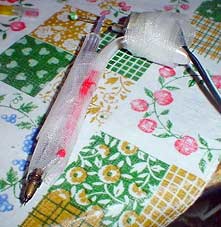 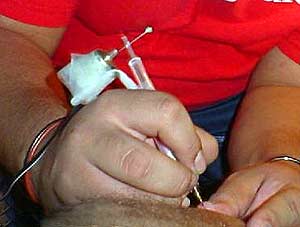 Improvised tattoo machine; electric motor, pen, and guitar wire.
|
| BME: | None of those supplies seem that sterile, especially if they’re used over and over on different people — so I’m wondering — what steps were taken to keep things clean, if any? Where were the tattoos done? |
| CAM: | For me, there was nothing done to sterilize anything. I bled very badly and they used a very dirty needle on me. Tattoos were done in the artist’s cell, and always with a few people keeping watch, as not to get caught in the act. |
| BILL: | People would boil the equipment in water, and the tattoos would usually be done in the tattoo artist’s cell. |
|
BEAR: |
I worked in the kitchen, so I had access to a pressurized steam kettle which had to be cleaned daily using bleach water. I would take the needles to work with me and then while cleaning the kettle, I would just put the needles in. Then I would wrap them in napkins and sneak them back to our cell. Tattoos were either in the bathroom (I know, it’s scary), or our cell. |
| BME: | With these very basic supplies, tattoos would be fairly simple designs, right? I mean, how intricate can a tattoo be that’s been done with a guitar string and ink from a pen? What were some common tattoos done in jail? |
| CAM: | There was a lot of racial or affiliation tattoos or tough stuff like tear drops and other masculine items. My tattoo was pretty unusual as it’s not too “manly.”
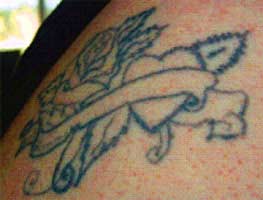 Cam’s tattoo, complete with a heart and rose.
|
| JAREB: | Because of the supplies available, only black and grey work was done, so there were a lot of skulls, gang symbols, names, and spider webs on the elbows. |
| BILL: | It was the same in my case: I saw a lot of chains, names, teardrops, images of clocks, spider webs and gang symbols. |
| BEAR: | Actually for some reason, names were popular; you would think that cons would know better. Once in a while, there was some really nice fantasy work done. |
| BME: | All of those themes are very similar, more than I thought there would be — especially because all of you went to different jails in different states and provinces, but what do they all mean? |
| BILL: | There’s always your common “done time” pieces, like I said: chains, locks, clocks, hourglasses, and so on. Spider webs on the elbow used to signify that you took a life, but it’s now become fashionable and doesn’t necessarily mean that anymore. Teardrops either mean that you took a life, or lost someone close to you.
Most gangs have there own specific symbols, which can also vary from which branch, hood, or part of the country or world they’re from. Bloods commonly use wolf prints, wolf heads, and other lupine symbols, as well as pentagrams. Crips use the Star of David, as well as a crescent moon, which is also commonly used by Five Percenters. The Latin Kings have a three pointed crown, and Aryans and Bikers use Nazi symbols. Then there’s the obvious symbols used by different Anglo groups, like Shamrocks for the Irish, and national flags for whatever the person’s background is. Memorials, portraits, and banners of loved ones are also very common. |
| BME: | So, let’s say that someone goes into jail who’s previously tattooed — all high quality work, and then they get tattooed in jail, and it turns out pretty badly. Are they given a lot of flack from other inmates about their standards? |
| BEAR: | That they are. If you have good work, and then get some crap, then people give you shit about it. Most people who have tattoos going in are kind of snobbish about jailhouse work. |
| BME: | Bear, you’ve been in several different jails — did you see much diversity in the tattoo culture between those jails? |
| BEAR: | In my incarcerations, I did not see a big change from prison to prison unless you are talking about gang related work. With the gang tattoos, if the gang represented was not strong in a particular prison, then the tattoos were downplayed and not on display as much, for obvious reasons. The one other change that I experienced was that as you worked your way down from maximum to medium and then onto minimum security, the quality of the work seemed to go down. I credit this to the fact that when you’re in maximum and someone messes you up in a permanent way, you have less to lose, and are more willing to seek revenge with physical retribution. |
| BME: | There are lots of people who come out of jail with swastikas and gang symbols that they eventually regret. They may regret them because the symbols don’t have any meaning outside of jail, because it reminds them of a bad time in their life, because they have changed so much and can’t relate to the person they were inside of jail, or just because the tattoo is of such poor quality. Do you regret getting your tattoo? |
| CAM: | No, not at all. |
BEAR: |
No, I do not. In fact, I am going to have it redone as it has faded somewhat. |
| BME: | Some men go into jail and come out without getting a tattoo, and there are other men who come out with lots of tattoos. If you were in jail for any longer, would you have gotten more? |
| CAM: | No. I got mine and that was enough. Again, I got it to show my respect to the people who watched my back — I can’t express how much the culture in jail revolves around trust and your word. It’s really all you’ve got. I got one outside of jail as well, but the experience was nothing like it was in jail, not only the procedure, but there were no politics involved with that one. |
| JAREB: | Yes, I would have. |
| BEAR: | Probably not, as I had already begun to collect cartoon characters and I did not want to ruin the theme. Besides, even with what we were doing for sterilization, it was dangerous. |
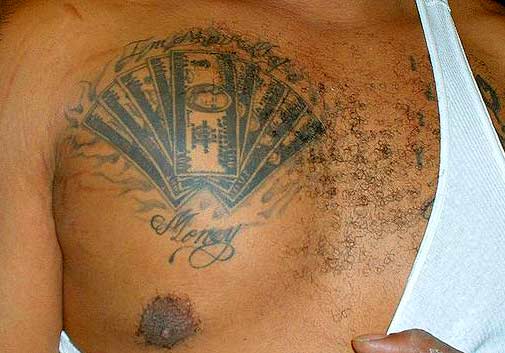 A tattoo born in prison. |
|
| BME: | Did your tattoo provide any safety against violence? |
| JAREB: | Yes and no. It showed the crew that I rolled with, and that comes with both safety and danger — it all depends on the politics of the gangs at the time. |
| BEAR: | No, it did not. Being six feet tall and 275 pounds did, I guess. And the old saying holds true: “Convicts do time, an inmate’s time does them.” If you don’t fuck with people, people don’t fuck with you. Usually. |
| BME: | Guards have enough to worry about — with violence and keeping everyone in check. Was it a priority for them to try to stop inmates from getting tattooed? |
| CAM: | It depended on the guard. If we were caught, we’d get time in the hole, and then time in the infirmary to have the damaged tissue removed. |
| JAREB: | The guards generally did nothing. Once in a while there’d be a raid and machines would be taken, but new ones would be made that same day. |
 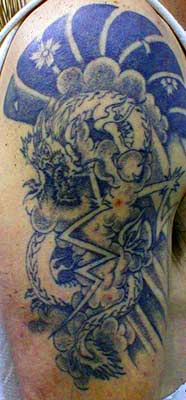 These tattoos were created by a single-needle machine in a prison in Michigan. |
|
| BME: | So, it’s been a while since you’ve gotten out of prison, but you still have your tattoo there to remind you of that time in your life. Bear, what do you think of your tattoo now (especially because your personality has changed so much)? |
| BEAR: | I used to be a very sick, racist asshole who was completely intolerant of anything or anyone different. It doesn’t make much sense because I am different than other people. One day, I just realized that fact and everything changed. While my tattoos remind me of a really crappy time in my life, they do show me where I was then and how much I’ve changed, and I like them for that. |
| BME: | As you may have heard, Canada is planning on implementing a “tattoo service,” which allows inmates to receive cheap and sterile tattoos. What do you think of this program? Do you think more inmates will get tattoos because of it? Have you known anyone to get hepatitis C or other illness from getting a tattoo? |
| CAM: | Cheap and sanitary tattoos are a good idea, but it may take away from that culture in jail. Earning a tattoo or being branded is important to inmates. Maybe they should start a program and let the inmates govern it, as the more they take from them, the worse things can get. I don’t know anyone who has gotten sick from it, but I’m sure it happens a lot — most probably wouldn’t discuss it. |
| JAREB: | I think more programs like this need to be implemented. Tattooing is never going to stop, and the health risks are too great. Maybe more inmates will get tattooed, maybe not, you can never really tell. I have known a lot of people to get really sick, and yes, get hep. It’s not nice to witness people getting sick from diseases that are not being treated because of where they are.
I think it is hard for people who have never been in jail to make rules for what should happen in jail. How can you tell someone to live a certain way if you yourself are never going to have to live it? |
| BEAR: | I think it is a very good idea. Prison should be about rehabilitation, not retribution. Part of being rehabilitated is improving your self image, and tattoos do that. I do think that more inmates will get tattoos, which is a shame since most will probably do it for the wrong reasons, and they won’t think it through. Plus, I would imagine that the administration will not allow gang tats, so those will remain underground. And while I’ve heard a few horror stories, I do not know anyone personally who has gotten anything from a tattoo. |

|
|
| BME: | How many people have you worked on who’ve been in jail and are looking for cover-up tattoos? |
| JOHANN: | I can’t recount the many times I have seen and worked on tattoos that originated in jail. I have probably documented at least about thirty or so over the years which were worth photographing. I know for a fact I have done many more than that, I just never took a picture of them (probably because it wasn’t that much of a noteworthy tattoo that they wanted me to cover their tattoo with, or they wanted me to rework the jailhouse line work and I had very little input on the tattoo). |
| BME: | We’ve heard from these men in this interview that gang related tattoos and other prison-themed work is common. What kinds of tattoos have you seen that people are interested in getting covered up? |
| JOHANN: | It differs from individual to individual, but most people usually cover up old gang insignia, racist imagery, vulgar or offensive lettering, or just plain ugly tattoos. Sometimes, they want me to rework some of their tattoos that they received on the “inside” and sometimes it’s possible to make it totally new and “cleaned” up. Sometimes the work is so badly scarred or blown out that I would liken the process to “polishing a turd.” |
| BME: | What should people know who are looking for cover-up work? It must a difficult task sometimes because of the colour of the initial ink and poor quality of the tattoo. |
| JOHANN: | The general rule of thumb concerning cover-up work is that usually only darker colors mask dark colors; meaning that you can’t put yellow over black line work and expect it to “erase” the black and make it appear yellow. There are factors involved as well, like how old the tattoo that is that’s going to be covered up, for example. You’d have a better chance of success blasting some yellow over some old black line work that has had twenty years to fade, as opposed to black line work from two years ago. Of course, yellow over a grayish faded black ends up being a muddied mix when layered on top of each other, but with the right skill and technique, it can totally be applied in a tattoo correctly without looking like a mistake.
So, with that in mind, darker imagery usually works best: panthers and eagles, and black tribal have been tried and true examples, although a lot of really talented folk out there can do a cover-up with much more lighter colors in the piece. A perfect example would be cover-ups by either THE GRIME or Guy Aitchison. Not to single those two out, as there are tons of talented artists out there, but those two stick out in my mind as masters of their craft and really do well in the cover up department. |
| BME: | Have you spoken to your customers about the specific reason behind wanting to cover up their tattoos? |
| JOHANN: | Some do it to rid themselves of a bad tattoo. They probably realized the difference in quality between different artists, as opposed to just having one choice of artist in jail. Others choose to cover it up so that they wont have to be haunted by reminders of their past. |
| BME: | Do they seem embarrassed about the work that they’ve gotten in jail? |
| JOHANN: | It’s a mixed bag. Some are regretful, and proceed to get a cover-up or get it lasered off, while others get tattooed around the jailhouse piece to remind themselves of their time inside. |
  Before and after shots: cover-up work by Johann. |
|
| BME: | Has anyone mentioned what kind of feedback they’ve gotten from people in the “real world”? |
| JOHANN: | One particular guy I tattooed, I covered a jailhouse swastika on his leg. Once he got out of jail, he went the straight and narrow and successfully found a job and had a family. Years later, other parents saw his swastika on his leg when he took his daughter to school while he was dressed shorts. Whether or not the swastika symbolized anything negative or positive, he felt that he didn’t want to jeopardize his daughter’s upbringing by other’s cultural views placed on him. |
| BME: | Did they mention why they got the ink they got (like for protection and so on)? |
| JOHANN: | Some said it was to pass the time, others said to show allegiance to their gang, whilst others found spirituality and wanted to show their devotion. For whatever reasons, there is some “intimidation” psychologically when one sees a tattooed inmate. It has been said that old sailors used to tattoo the face of Jesus on their backs to save themselves from lashings. Perhaps this mentality is still shared today? |
| BME: | What is the general quality of the tattoos you’ve seen born in prison? |
| JOHANN: | Where there is a will, there is a way. I never doubt the power of desire. A lot of talented people exist in all walks of life, including those who are incarcerated. Inasmuch as there are a lot of bad tattoos done in jail, there are also a few artists who are exceptional and do amazing work.
Given the limitations (tattoos are usually illegal to do inside prisons and materials are scarce) and lack of color, I have seen beautiful work done with just a makeshift rotary machine and a single needle. I have to respect that determination. |
  More cover-up work by Johann. |
|
In addition to the health risks, there is the risk of social stigma after release from prison with the popularity of gang symbols and extremist racial views. While behind bars these are overall accepted and respected, once the person completes their sentence, they’ve got something on their bodies that they may not be so proud of any more. They’re “stuck” with a marking on their body that can really only remind them (and the people who see it) of one thing — doing time — and if they’re not proud of that, then there’s an expensive problem. Laser treatment is an option, but people can expect to pay hundreds of dollars per visit, and most need between six and twelve treatments. That’s a lot of money.
Lucky for people like Johann, there’s been a consistent flow of people coming into his studio looking for cover-up work. As far as hiding the work you’ve gotten done in prison, it’s probably the most economical method: a palm sized tattoo by Johann would cost about $150.00.
Overall I agree with the CSC program — I’m a strong believer in avoiding problems rather than attempting to fix them once they happen. Tattooing in jails is unavoidable and I don’t think a lot of the men in prisons necessarily care about the consequences of their actions — I mean, if they did, they likely wouldn’t be in jail in the first place, right? We, the people on the outside, may as well make it as safe for them as we can, if not for their sakes, for ours.
– Gillian Hyde (IAM:typealice)
Gillian Hyde (IAM:typealice) is a vagabond, though her roots run deep into Nova Scotian soil. She’s lived and worked on three continents since 2001, and has never lived anywhere for longer than eight months since the age of 16. She loves fonts, puns, being barefoot, and office supplies. Calm to her is the roar of the ocean. Online presentation copyright © 2005 BMEzine.com LLC. All cover-up images are © Johann Florendo.Images of tattooed arms are © Patrick Warnement. All other tattoo images are from the BME archives. Requests to republish must be confirmed in writing. For bibliographical purposes this article was first published online April 16, 2005 by BMEzine.com LLC from La Paz, BCS, Mexico.








 BME/News and Modblog highlight only a small fraction of what
BME/News and Modblog highlight only a small fraction of what
This is one of the main problems of current political participation projects in Germany: Many newly youth-created local youth councils or parliaments get infiltrated by young party members who manipulate young people not yet involved in the political process who seek ways to find their own identity and play adult roles as early as possible. ,